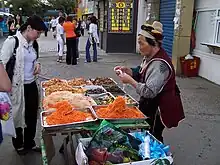Koryo-saram cuisine
Koryo-saram (Korean: 고려사람; Russian: Корё сарам; Ukrainian: Корьо-сарам; Uzbek: Корё-сарам) are ethnic Koreans of the former Soviet Union. They have a distinct style of cuisine that is descended from Korean cuisine and influenced by the cuisines of various countries they have lived in. Sakhalin Koreans are a similar group who descend from Koreans on the island of Sakhalin, although they are often considered distinct from other Koryo-saram.[1] They have also contributed dishes that have become adopted into the wider Koryo-saram cuisine.
The cuisine has achieved significant popularity throughout the former Soviet Union, with dishes like morkovcha widely available in grocery stores, and street foods like pyanse achieving significant popularity in Vladivostok and Moscow. However, to the reported suprise of some visitors from Russia, the cuisine is virtually unknown in South Korea. It is also considered by some to differ from South Korean cuisine significantly, especially as it descends primarily from the cuisine of regions now in North Korea.
Description
Of Korean regional cuisines, Koryo-saram cuisine is most closely related to that of the Hamgyong provinces, now in North Korea. This is because many Koryo-saram are descended from people from that area.[2]
Many of the dishes are adaptations of Korean dishes that use ingredients that Koryo-saram had access to.[3][4] For example, while pork is popular in Korea, Koryo-saram cuisine in Uzbekistan lacks it since it's not widely available as a result of Islamic dietary restrictions on the consumption of pork.[4] Seafood is also popular in Korea, but inland Koryo-saram do not consume it.[4] The cuisine was also adjusted to suit the tastes of local non-Korean customers, notably by reducing the amount of pepper used.[3]
Koryo-saram also consume food typical to the region that they are in. For example, a significant proportion of Korean Ukrainians move to South Korea for work. Many of them report that they miss Ukrainian food and enjoy South Korean food less than their food from back home.[5] Cafe Lily, an Uzbeki Korean restaurant in New York City, serves Central Asian cuisine alongside Koryo-saram cuisine.[6]
The cuisine is also considered so distinct from South Korean cuisine (in part because it descends from cuisine from areas now in North Korea) that some Koryo-saram, like notable academic German Kim,[4] find many South Korean dishes unpleasant and unfamiliar.[4][7] Russians are reportedly surprised when they visit South Korea and find that morkovcha is virtually unknown.[3]
Koryo-saram have also incorporated elements of Korean cuisine into other dishes, particularly through the use of Korean spices.[4]

Some of Koryo-saram dishes have achieved significant popularity throughout the former Soviet Union. Morkovcha can be found pre-made in many grocery stores.[8][9] Pyanse, a Sakhalin Korean dish, has been popular in Vladivostok since the 1990s. In 2014, Russian entrepreneurs brought the dish to Moscow, and in 2016, there were 10 stores in the central district that sold it.[10]
List of dishes
Koryo-saram cuisine
- Jimchi (чимчхи) – descendent of kimchi, made without saeu-jeot.[11] Name pronunciation comes from the Hamgyong Province pronunciation of the word.[12]
- Morkovcha – carrot-based dish descended from kimchi.[13] Commonly called "Korean carrot salad" in Russian.[9]
- Kuksu – a cold noodle dish descended from janchi-guksu[14][6]
- Funchoza – noodle salad dish, variant of japchae[15][16]
- Begodya – steamed buns similar to jjinppang-mandu[6]
- Sundya – blood sausage descended from sundae[6]
- Bukjai (пуктя́й) – a soybean stew descended from doenjang-jjigae. In one restaurant in Ddaetgol Village in South Korea, the dish was served with tomatoes, cabbage, and a hardboiled egg[11]
Sakhalin Korean cuisine
- Pyanse – steamed buns invented in the early 1980s as an adaptation of wang-mandu[10][17]
- Paporotnik – dried and boiled ferns, seasoned with sesame oil, pepper, and garlic[17]
- Lopukh – burdock that is boiled, fried, and seasoned[17]
- Morskaya kapusta – boiled seaweed salad[17]
- Khe – a marinated raw fish dish descended from hoe[6]
- Hemultan – spicy seafood stew descended from haemultang[17]
- Shyupaltsa – name meaning "tentacle", contains squid, carrots, apples, egg, and onion[17]
References
- "Sakhalin's Koreans". The Sakhalin Times. 20 January 2004. Archived from the original on 20 November 2006. Retrieved 27 November 2006.
- Lee, Kwang-kyu (2000), Overseas Koreans, Seoul: Jimoondang, p. 249, ISBN 89-88095-18-9
- Lankov, Andrei (21 August 2012). "Korean carrot". Russia Beyond the Headlines. Archived from the original on 28 September 2013. Retrieved 22 December 2016.
- Hay, Mark (2018-09-10). "How Survivors of Stalinism Created a New Korean-Fusion Cuisine". Atlas Obscura. Retrieved 2023-10-09.
- Logvynenko, Bogdan; Horban, Diana (2019-10-30). "Koreans of Ukraine. Who are they? • Ukraїner". Ukraїner. Retrieved 2023-10-08.
- Mishan, Ligaya (16 February 2017). "At Cafe Lily, the Korean-Uzbek Menu Evokes a Past Exodus". The New York Times. Retrieved 2 January 2019.
- ""마리우폴에 있는 집 폭격 피해 한국행… 고려인 밥심은 나물 반찬"[나를 살리는 밥심]". 서울신문 (in Korean). 2022-05-22. Retrieved 2023-10-09.
- "This Simple Carrot Salad Tells the Story of a Diaspora". Atlas Obscura. Retrieved 2023-10-09.
- Eremeeva, Jennifer (2020-06-27). "Taming Morkovcha — Russia's Beloved Korean Carrot Salad". The Moscow Times. Retrieved 2023-10-09.
- Rossiyskaya Gazeta (25 June 2016). "What's hot about pyanse, Vladivostok's most popular street food". Russia Beyond. Retrieved 8 February 2018.
- "맛과 눈으로, 땟골마을에 녹아든 고려인 정착기". 고대신문 (in Korean). 2022-03-27. Retrieved 2023-10-09.
- "Kimchi? чимчхи[Jimchi]! Is It Korean?". The Argus (in Korean). 2020-10-16. Retrieved 2023-10-09.
- Lankov, Andrei (21 August 2012). "Korean carrot". Russia Beyond the Headlines. Archived from the original on 28 September 2013. Retrieved 22 December 2016.
- "Moscow Restaurants: Koryo-saram at K-Town". themoscowtimes.com. 2016-10-24. Retrieved 2 January 2019.
- 이명숙 (2017-02-28). "한식 대중화의 일등 공신 고려인 동포, 그들을 위한 배려의 필요성". 한국국제문화교류진흥원. Retrieved 2018-12-25.
- "Korean glass noodle salad "Funchosa" detailed photo and video recipe". Mix Markt. Retrieved 2023-10-06.
- RBTH, Ajay Kamalakaran (2016-07-01). "Russo-Korean cuisine: 7 delicacies from the Russian Far East". Russia Beyond. Retrieved 2023-10-09.

